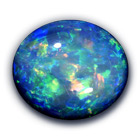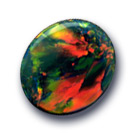Rainbow colored opal is the birthstone for the month of October and the National gemstone of Australia, where most opals are found.
 The opal is a unique gemstone, with an amazing array of colors that play within the stone. Considered a lucky stone, the opal’s history dates back to the aborigines of the Australian outback and has been made famous by such notables as Shakespeare, Pliny, and England’s Queen Victoria.
The opal is a unique gemstone, with an amazing array of colors that play within the stone. Considered a lucky stone, the opal’s history dates back to the aborigines of the Australian outback and has been made famous by such notables as Shakespeare, Pliny, and England’s Queen Victoria.
Rainbow Opal
Opal is considered a mineraloid gel because it is essentially a mineral but does not form a crystalline form. Inside the structure of an opal, spheres of silica form a lattice that gives the gemstone a solid form and also creates the amazing refraction of colors and light that make an opal so magical.
Opals can be white, black, milky, reddish, gold, blue, or almost any color of the spectrum, with an associated rainbow of other colors that are diffracted from within by the silica. Black and dark opals are the most valuable, as well as those with the most impressive diffracted colors.
 Opals have a hardness of 5.5 to 6 on the Mohs scale, but they can be brittle unless properly cared for. With a water content of 2 to 20%, they should be worn frequently or exposed to humidity and oiled to preserve their colors and keep the stones from cracking.
Opals have a hardness of 5.5 to 6 on the Mohs scale, but they can be brittle unless properly cared for. With a water content of 2 to 20%, they should be worn frequently or exposed to humidity and oiled to preserve their colors and keep the stones from cracking.
Opals in History and Myth
In Australia, where most gemstone-quality precious opals are found, the opal is said by Aborigine legend to have sprung into being when the foot of the creator touched ground on a mission to bring peace to all human beings. The opals sparkle like the rainbow the creator walked on to visit the Earth.
The Roman writer Pliny described opals as a stone with “the fire of the carbuncle, the brilliant purple of the amethyst and the sea-green color of the emerald, all shining together in incredible union.” Shakespeare called opals “the queen of gems.” An opal was set in the crown of the Holy Roman Emperor and in the crown jewels of France.
Queen Victoria broke a 19th-century stigma on opals by giving the gems as wedding gifts to many of her royal relatives. French actress Sarah Bernhard, whose birthday was in October, always wore birthstone opals, popularizing them at the turn of the 20th century.
Opal is the national gemstone of Australia and the gemstone for the 14th and 18th wedding anniversaries. Opal shares the month of October with another birthstone, tourmaline.
Magical Significance and Powers Ascribed to Opals
Like most gemstones, opal has been attributed with a long list of healing and magical powers. Opals are said to:
- cure eye disease
- balance the left and right brain
- instill faithfulness, confidence, and good luck
- enhance creativity
- resolve depression
- aid in the search for true love
- protect against the evil eye (black opals worn near the heart)
- dispel bad dreams
The ever-changing colors of the opal are said to be connected with emotions.
Opal Gemstones in Jewelry
An opal glitters with all the colors of the rainbow, making it a fitting highlight for almost any outfit. Opals are often seen in bracelets, fine pendants, earrings, and rings, where the dazzling “fire” or play of colors within the stone can be shown off to its best effect.
Opals are routinely cut in cabochon, a rounded half-circle, or other smooth forms to best display their fire. The exceptions to this rule are the highly prized fire opals mined in Mexico, which have a transparent red or golden color. Fire opals are sold in more traditional, faceted gemstone cuts and conventional settings.
Reference
- All That Gifts, “Gemstones: Opal,” All-That-Gifts.com, 2005.
- Coyle Wholesale Jewelers, “Opal,” CWJewelers.com, 1999.
- International Colored Gemstone Association, “Opals,” Gemstone.org, 2009.
